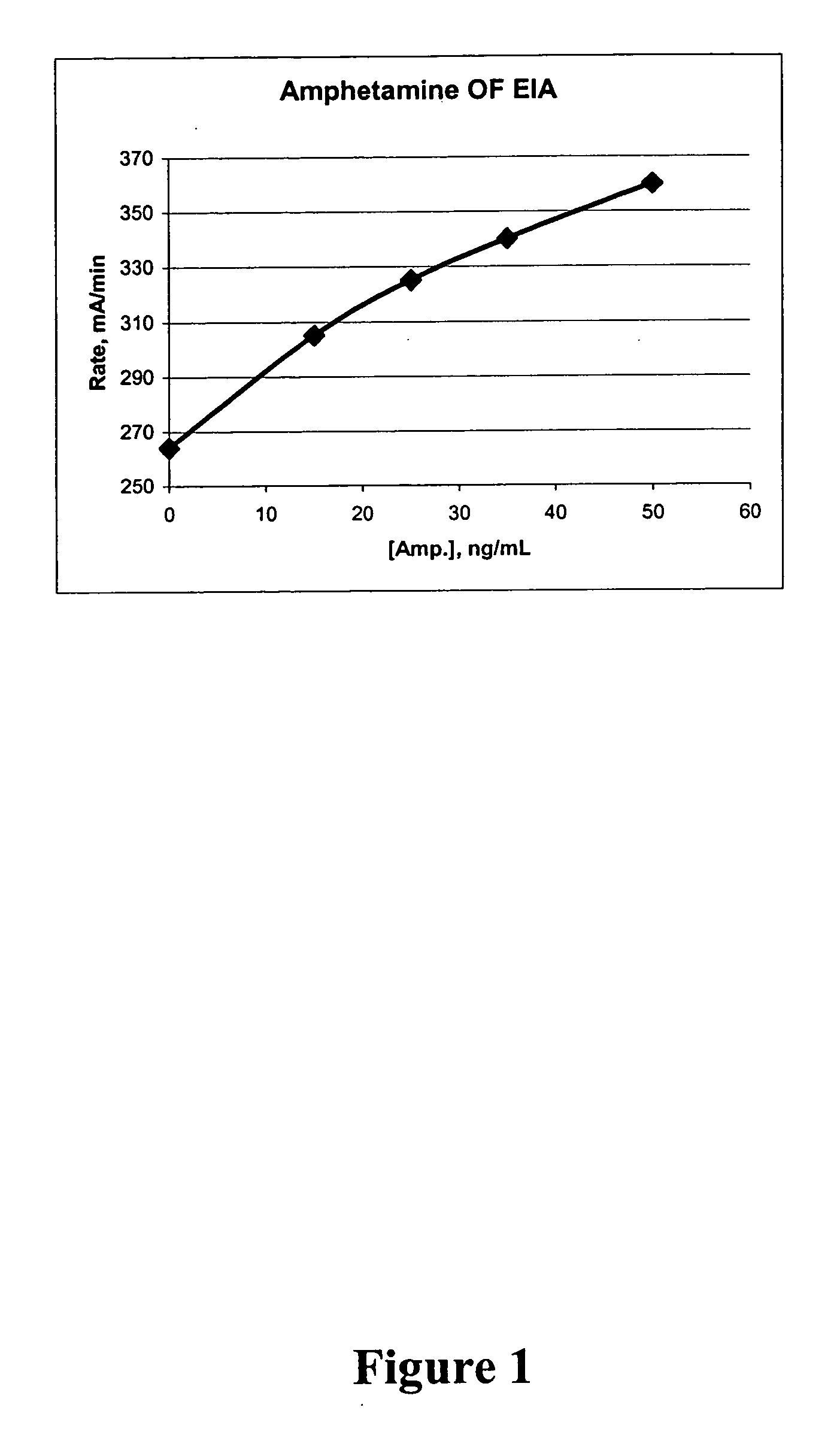Homogeneous enzyme immunoassay for oral fluid
an enzyme immunoassay and oral fluid technology, applied in the field of immunoassays, can solve the problems of inability to volunteer, inability to provide, information, and inability to collect samples,
- Summary
- Abstract
- Description
- Claims
- Application Information
AI Technical Summary
Benefits of technology
Problems solved by technology
Method used
Image
Examples
example 1
Calculation of Enzymatic Activity of the Enzyme-Analyte Conjugate
[0213] In order to measure accurately the analyte concentration in a sample suspected of containing an analyte, the signal (expressed as ΔA / min) generated between a negative calibrator, i.e., a calibrator with 0 ng / ml analyte and high calibrator, such as a calibrator with 50 ng / ml analyte by the G6PDH preferably should be at about 100 mA / min (rate mode). Thus, in a typical homogeneous enzyme immunoassay of this invention, G6PDH generates about 100 mA / min. The following equation states the relationship of signal intensity, enzyme activity, and reaction volume.
Enzyme Activity=ΔA×Vt / NADH×VR2, [0214] wherein ΔA is the signal generated by G6PDH (expressed in absorbent or milli-absorbant units); Vt is the total reaction volume in milliliter (ml) and includes volume of test sample, R1 (volume of antibody or receptor, substrate, co-factor), and R2 (volume of enzyme-analyte conjugate); NADP is the extinction coefficient of NA...
example 2
G6PDH-PCP Conjugate
[0224] G6PDH with a starting specific activity of 860 units / mg was purchased from USB Biochemical. Nineteen (19) mg of the G6PDH was conjugated with PCP hapten leading to 45% of deactivation. After purification, 13 ml of enzyme-PCP conjugate (1.4 mg / ml) was isolated. The purified enzyme-PCP conjugate was further inhibited by up to 60% upon binding of antibody reactive to PCP. An enzyme reagent at 1 to 2,000 fold of dilution was formulated which contained 0.731 μg / ml of enzyme-PCP conjugate. In a desirable immunoassay, 20μ-45 μl of sample, 75 μl of enzyme-PCP conjugate, and 150 μl of antibody solution were used. The following calculation illustrate the importance of % deactivation, % inhibition, and sample volume.
1. Enzyme concentration in the reagent:0.000731mg / ml2. Enzyme per assay (75 μl per assay):0.0000548mg / assay3. Normalize to 1.0 ml (from 0.245 ml0.000224mg / ml assay volume):4. Enzyme activity after 45% deactivation:0.1058units / ml5. Needed enzyme to gen...
example 3
G6PDH-Opiate Conjugate
[0226] G6PDH enzyme (4 mg, starting specific activity 860 units / ml) was conjugated with opiate hapten. 8.5 ml of G6PDH-opiate conjugate was purified. The conjugation resulted in 45% of deactivation of G6PDH. Opiate antibody binding to the G6PDH-opiate conjugate resulted in 52% of inhibition. The conjugate was formulated to the enzyme reagent at 1 to 450 dilution. By the same way of calculation as shown in Example 1, the following results are obtained:
1. Enzyme concentration in the reagent:0.00106mg / ml2. Enzyme per assay (75 μl per assay):0.0000784mg / assay3. Normalize to 1.0 ml (from 0.245 ml0.000320mg / ml assay volume):4. Enzyme activity after 45% deactivation:0.1514units / ml5. Needed enzyme to generate 100 mA:0.0525units / ml6. Sample 20 μl will have 15% reversible0.02270units / ml inhibition:7. Signal generated by 0.0370 unit of enzyme:43.3mA8. Sample 45 μl will have 20% reversible0.0303units / ml inhibition:9. Signal generated by 0.0540 unit of enzyme:57.7m...
PUM
 Login to View More
Login to View More Abstract
Description
Claims
Application Information
 Login to View More
Login to View More - R&D
- Intellectual Property
- Life Sciences
- Materials
- Tech Scout
- Unparalleled Data Quality
- Higher Quality Content
- 60% Fewer Hallucinations
Browse by: Latest US Patents, China's latest patents, Technical Efficacy Thesaurus, Application Domain, Technology Topic, Popular Technical Reports.
© 2025 PatSnap. All rights reserved.Legal|Privacy policy|Modern Slavery Act Transparency Statement|Sitemap|About US| Contact US: help@patsnap.com



